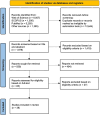Etiology-specific incidence and mortality of diarrheal diseases in the African region: a systematic review and meta-analysis
- PMID: 38997671
- PMCID: PMC11241906
- DOI: 10.1186/s12889-024-19334-8
Etiology-specific incidence and mortality of diarrheal diseases in the African region: a systematic review and meta-analysis
Abstract
Background: Diarrheal diseases substantially affect public health impact in low- and middle-income countries (LMIC), particularly in Africa, where previous studies have indicated a lack of comprehensive data. With a growing number of primary studies on enteric infections in Africa, this study aimed to estimate the incidence and mortality of diarrheal pathogens across all ages in Africa in the year 2020. We also explored different methodological assumptions to allow comparison with other approaches.
Methods: Through a systematic review and meta-analysis of data from African LMICs, we estimated the etiology proportions for diarrheal diseases and deaths. We combined the etiology proportions with incidence data collected from a population survey in Africa from 2020 and mortality data from the Global Health Observatory of WHO.
Results: We estimated 1,008 billion diarrhea cases (95% UI 447 million-1,4 billion) and 515,031 diarrhea deaths (95% UI 248,983-1,007,641) in the African region in 2020. In children under five, enteroaggregative E. coli (EAEC) (44,073 cases per 100,000 people, 95% UI 18,818 - 60,922) and G. lamblia (36,116 cases per 100,000 people, 95% UI 15,245 - 49,961) were the leading causes of illness. Enteroinvasive E. coli (EIEC) (155 deaths per 100,000 people, 95% UI 106.5-252.9) and rotavirus (61.5 deaths per 100,000 people, 95% UI 42.3-100.3) were the primary causes of deaths. For children over five and adults, Salmonella spp. caused the largest number of diarrheal cases in the population of children ≥ 5 and adults (122,090 cases per 100,000 people, 95% UI 51,833 - 168,822), while rotavirus (16.4 deaths per 100,000 people, 95% UI 4.2-36.7) and enteroaggregative E. coli (EAEC) (14.6 deaths per 100,000 people, 95% UI 3.9-32.9) causing the most deaths. Geographically, the highest incidence of diarrhea was in Eastern Africa for children under five (114,389 cases per 100,000 people, 95% UI 34,771 - 172,884) and Central Africa for children over five and adults (117,820 cases per 100,000 people, 95% UI 75,111-157,584). Diarrheal mortality was highest in Western Africa for both children below five and above (children < 5: 194.5 deaths per 100,000 people, 95% UI 120-325.4; children ≥ 5 and above: 33.5 deaths per 100,000 people, 95% UI 12.9-75.1).
Conclusion: These findings provide new information on the incidence and mortality of sixteen pathogens and highlight the need for surveillance and control of diarrheal infectious diseases in Africa. The cause-specific estimates are crucial for prioritizing diarrheal disease prevention in the region.
Keywords: Aetiology; Africa; Diarrheal disease; Diarrheal incidence; Mortality; low-and-middle income countries.
© 2024. The Author(s).
Conflict of interest statement
Sara M. Pires and Shannon Majowicz are members of the World Health Organization’s Foodborne Disease Burden Epidemiology Reference Group (FERG).Shannon Majowicz is an expert on the Joint FAO/WHO Expert Meetings on Microbiological Risk Assessment (JEMRA) Roster of Experts. All other authors have no competing interests.
All other authors had no competing interests.
Figures


References
-
- World Health Organization. Diarrhoeal disease [Internet]. 2017 [cited 2022 Dec 2]. https://www.who.int/news-room/fact-sheets/detail/diarrhoeal-disease.
-
- World Health Organization. Food safety [Internet]. 2022 [cited 2023 Nov 23]. https://www.who.int/news-room/fact-sheets/detail/food-safety.
-
- Null C, Stewart CP, Pickering AJ, Dentz HN, Arnold BF, Arnold CD, et al. Effects of water quality, sanitation, handwashing, and nutritional interventions on diarrhoea and child growth in rural Kenya: a cluster-randomised controlled trial. Lancet Glob Health. 2018;6(3):e316–29. doi: 10.1016/S2214-109X(18)30005-6. - DOI - PMC - PubMed
Publication types
MeSH terms
Grants and funding
LinkOut - more resources
Full Text Sources
Medical
Miscellaneous

